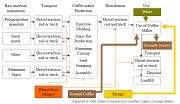Life cycle assessment
From DDL Wiki
Life Cycle Assessment is a technique for assessing the environmental aspects and potential impacts associated with a product or service, by
- compiling an inventory of relevant inputs and outputs of the system;
- evaluating the potential environmental impacts associated with those inputs and outputs;
- interpreting the results of the inventory analysis and impact assessment phases in relation to the objectives of the study.
There exist two primary categories of LCA:
- Process LCA (also traditional LCA or SETAC LCA) as defined by ISO 14000 standards, involves defining an appropriate scope and systematically accounting for all interactions of product/processes with the environment. It is generally difficult or impossible to define a complete scope, since use of materials and energy purchased from other firms implies additional use of the materials and energy used by that firm's production, transportation, and so on in a long chain.
- EIO-LCA, or Economic Input-Output LCA involves use of aggregate sector-level data on how much environmental impact can be attributed to each sector of the economy and how much each sector purchases from other sectors. Such analysis can account for long chains (for example, building an automobile requires energy, but producing energy requires vehicles, and building those vehicles requires energy, etc.), which somewhat alleviates the scoping problem of process LCA; however, EIO-LCA relies on sector-level averages that may or may not be representative of the specific subset of the sector relevant to a particular product.
- Hybrid LCA describes approaches to blending data from EIO and process models. For example, one might use process LCA to capture all of the aspects that can be measured within the scope of the study and use EIOLCA to capture the supply chain outside of the system boundary.
Links
- EIOLCA Software
- Using EIOLCA to evaluate a product
- Hendrickson, C. T., Lave, L. B., and Matthews, H. S. (2005) Environmental Life Cycle Assessment of Goods and Services: An Input-Output Approach, Resources for the Future Press.
- ISO 14000 Standards
- Design for environment


